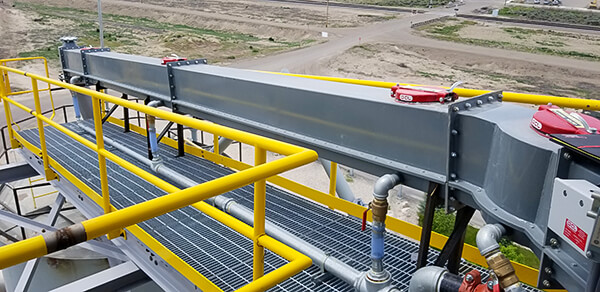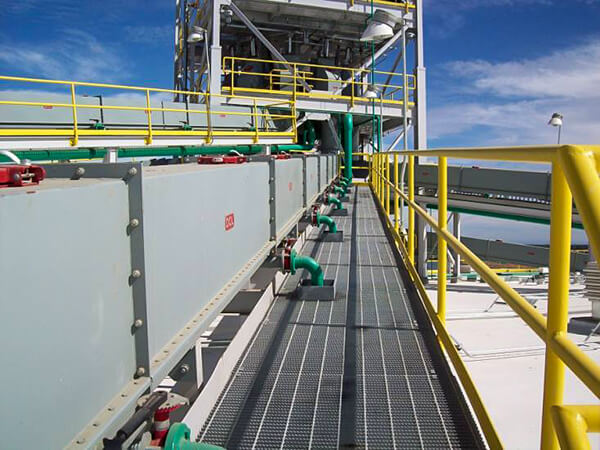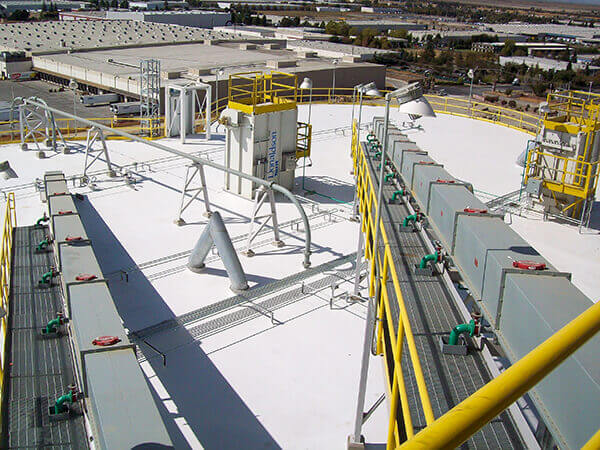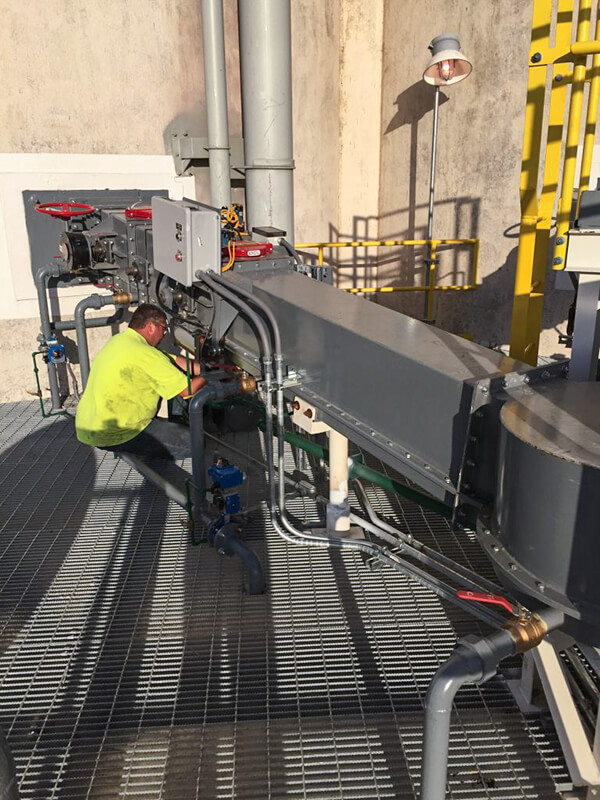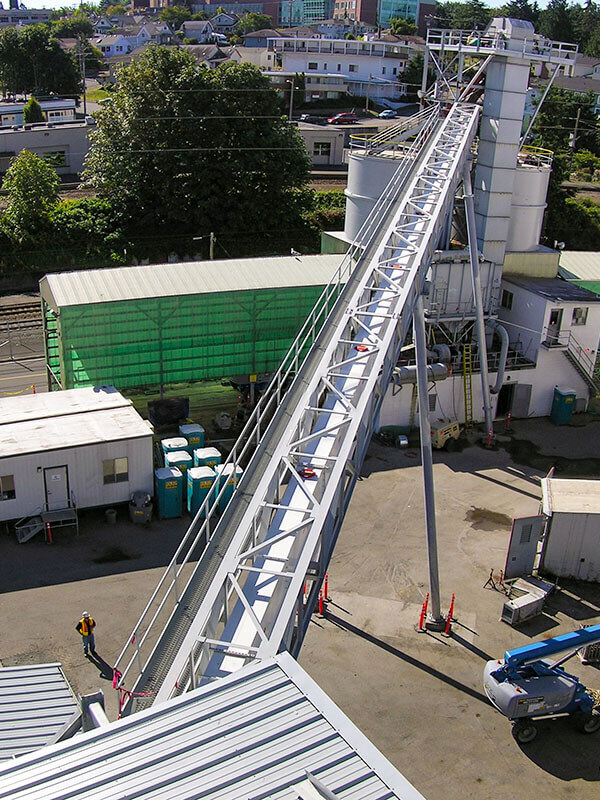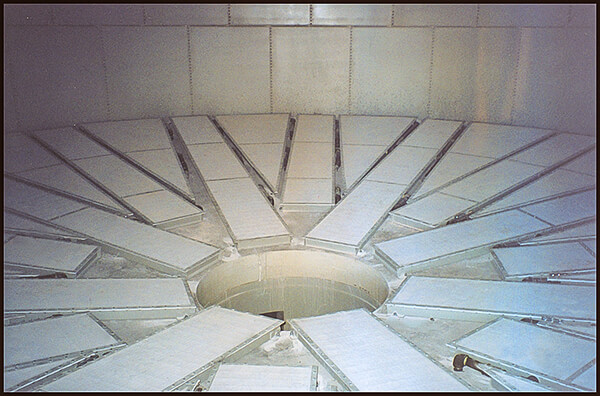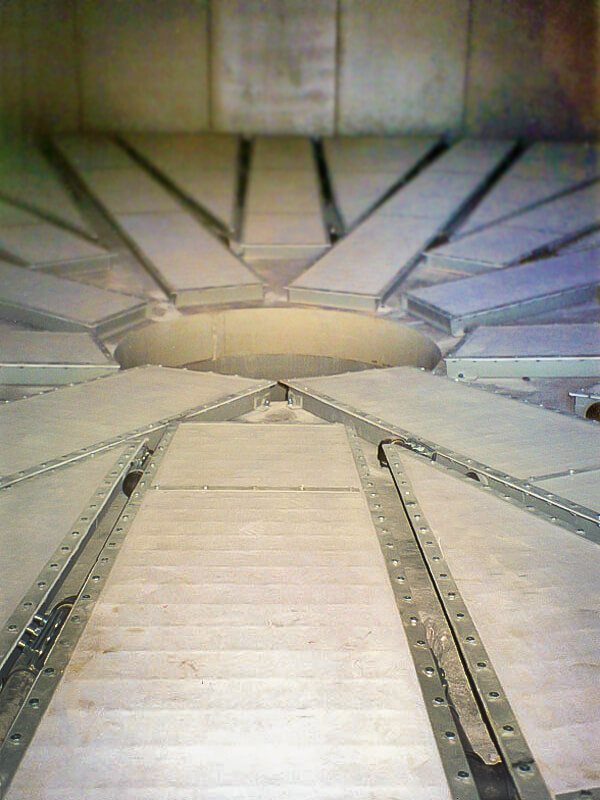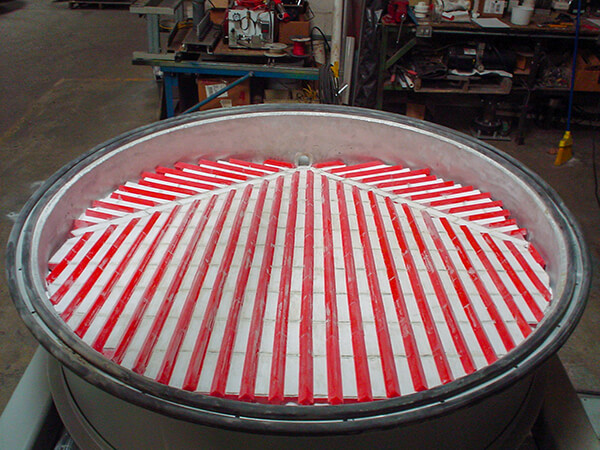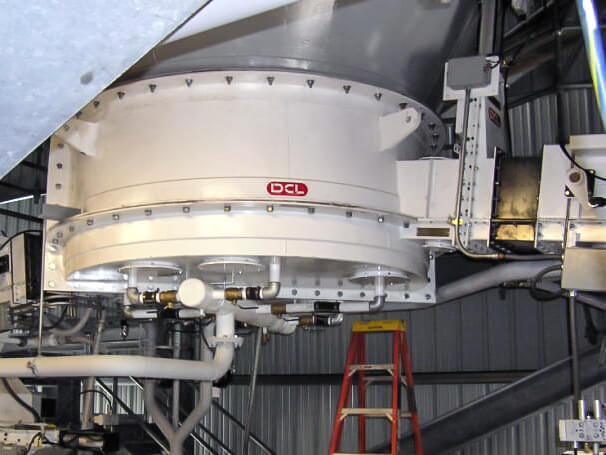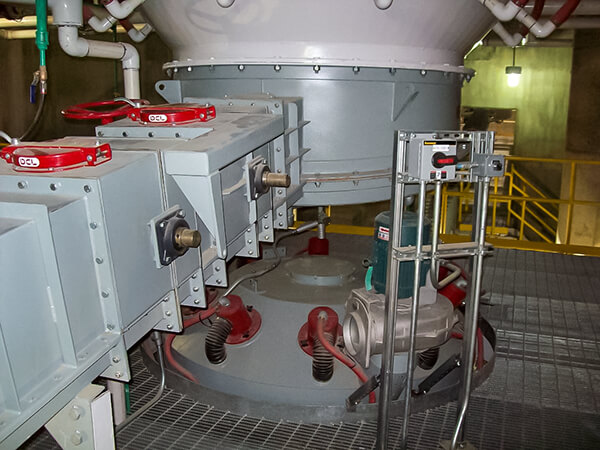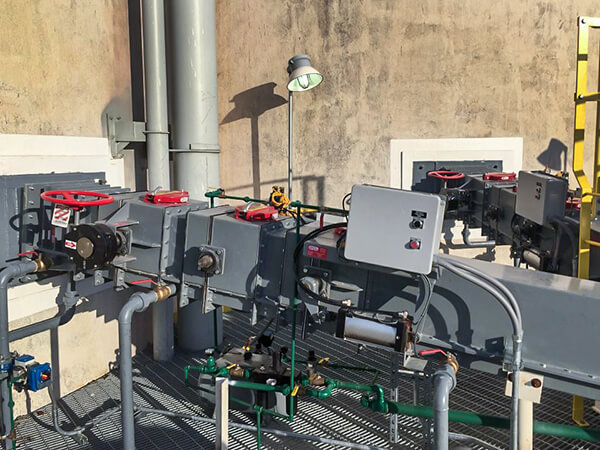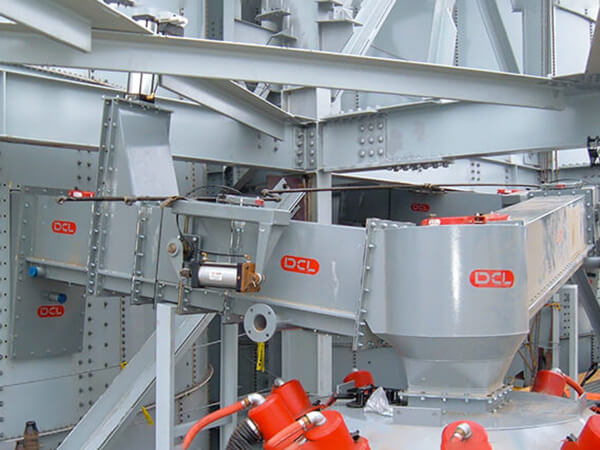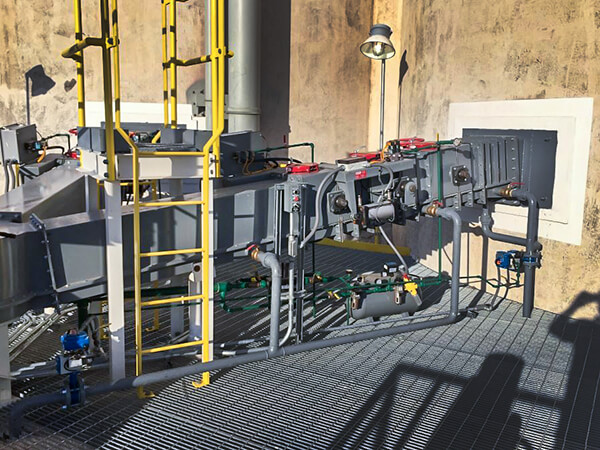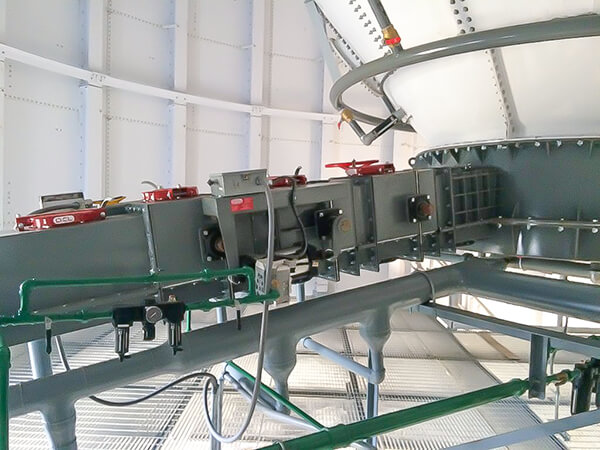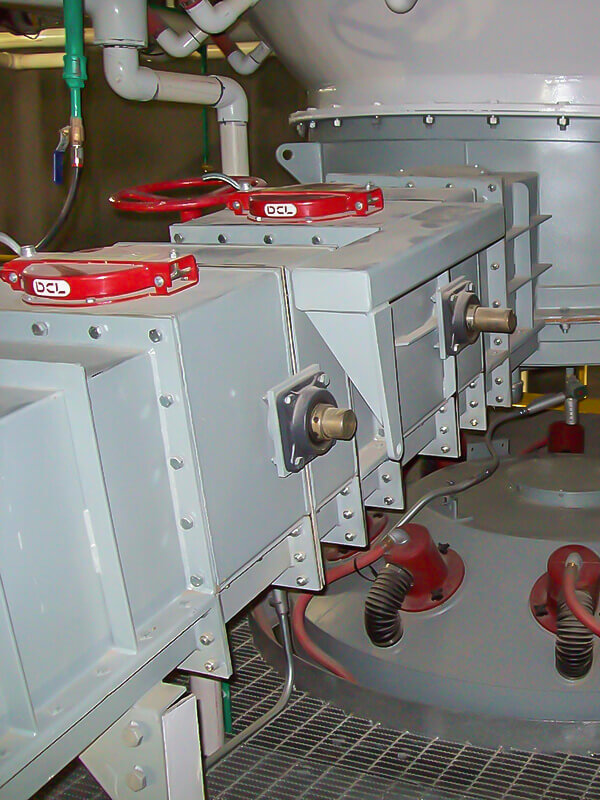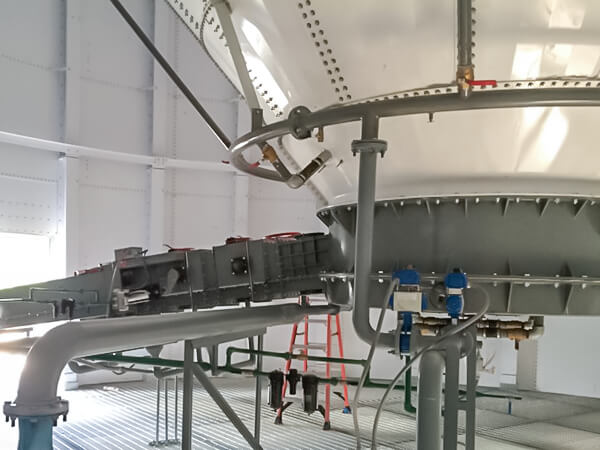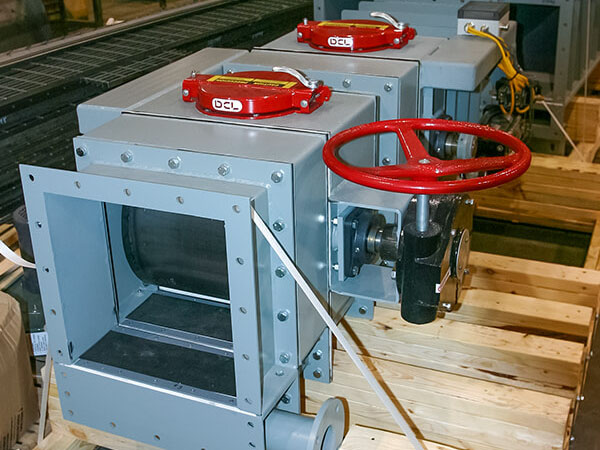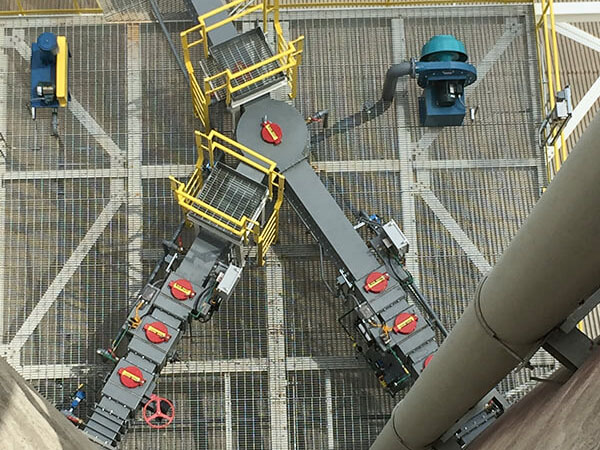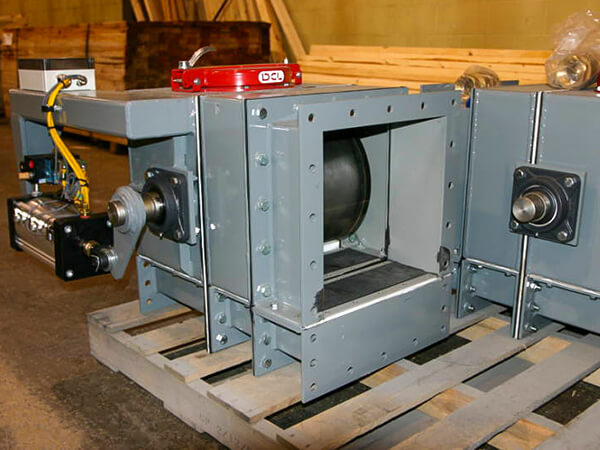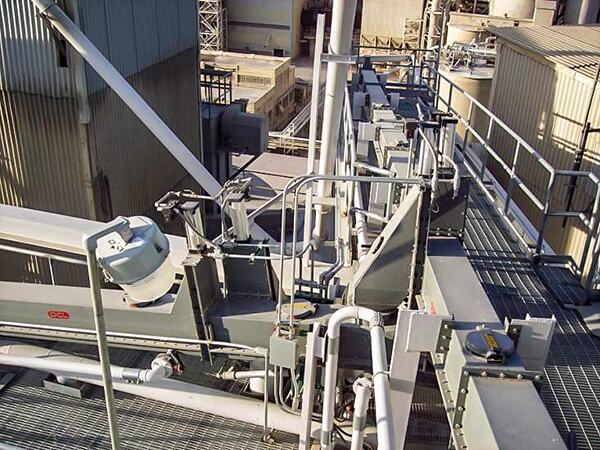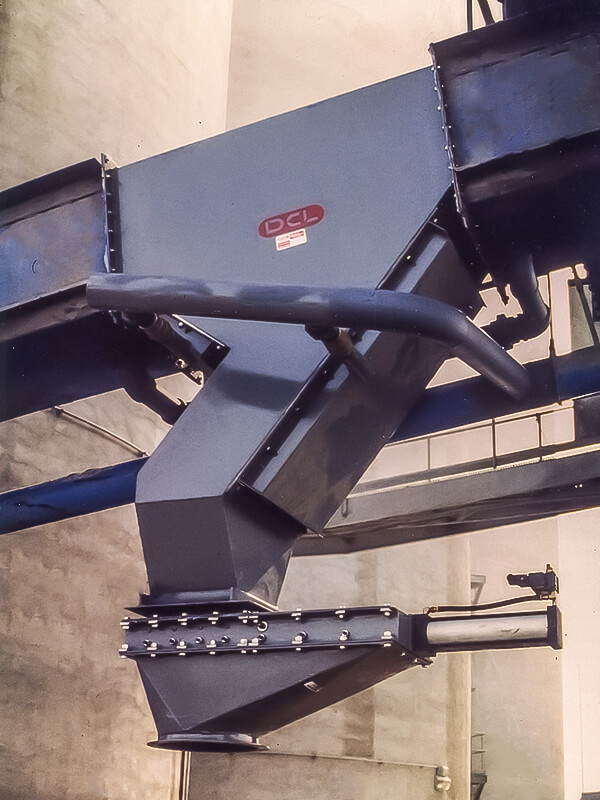Aeration Equipment
AERATION CONVEYORS (AIR SLIDES)
Conveys dry bulk materials from point A to point B on a downward slope.
Sizes from 6” to 36” wide with conveying capacities up to 1,000 CFM.
Aeration conveyors (Air Slides) are used to gravity-convey powders by passing low-pressure air through a porous membrane media and into the bed of the material being handled.
You can handle a large variety of materials with aeration conveyors regardless of their abrasive nature or bulk density. The criteria are particle size, moisture content and temperature. Generally a product should have a particle distribution of 100% through a 20 mesh screen. Moisture content should be below 1% and temperature can not exceed 1200 degrees Fahrenheit [649˚ C].
The absence of moving parts and low power requirements make air gravity conveying the most economical way to convey fine materials over short or long distances.
DCL can perform a product compatibility test for you to determine the optimum conveying angles and aeration volumes for your application. We’ll need a minimum product amount of 2 cubic feet [0.07 m³] to conduct a proper test.
We offer a large selection of aeration conveyors from 6 inches [152 mm] wide up to 36 inches [914 mm] wide, with conveying capacities up to 1000 cubic feet per minute [28.3m³/min]. Conveyors also are available in a high top or low top design, offering you maximum flow rate or minimum headroom to best suit your application.
A choice of construction materials allows you to effectively handle all types of products – fine, abrasive and corrosive – and difficult dusty or sanitary applications.
AERATION TROUGHS (AIR PADS)
Aerates dry bulk material inside silos, bins, and domes.
Sizes from 6” to 24” wide.
Aeration troughs (air pad) are used to promote consistent product withdrawal from large-diameter flat or conical-bottom storage silos. It works by passing low-pressure air through a porous membrane media and into the bed of the material being handled. The low-pressure air is then passed up through the material in the silo giving it a highly fluid property. Troughs are typically mounted inside the conical section of the silo and are equally spaced along a 360-degree pattern. However they can also be used in flat-bottom domes and rectangular storage buildings and only require a 6 degree slope from the inner wall of the silo to the discharge point.
The absence of moving parts and low power requirements make air gravity conveying the most economical means to convey fine materials over short or long distances. You can handle a large variety of materials with aeration conveyors regardless of their abrasive nature or bulk density. The criteria are particle size, moisture content and temperature. Generally a product should have a particle distribution of 100% through a 20 mesh screen. Moisture content should be below 1% and temperature can not exceed 1200 degrees Fahrenheit [649˚ C].
DCL can perform a product compatibility test for you to determine the optimum conveying angles and aeration volumes for your application. We’ll need a minimum product amount of 2 cubic feet [0.07 m³] to conduct a proper test.
We offer a selection of aeration troughs from 6 inches [152 mm] wide up to 24 inches [610 mm] wide.
A choice of construction materials allows you to effectively handle all types of products – fine, granular, lumpy, abrasive and corrosive – and difficult dusty or sanitary applications.
AERATION BIN BOTTOMS
Aerates dry bulk material inside the bottom of silos and bins.
Sizes from 2’-0” to 16’-0” diameter with multiple discharge configurations.
Aeration bin bottoms are used to promote consistent product withdrawal from large-diameter flat- or conical-bottom storage silos. It does this by passing low-pressure air through a porous membrane media and into the bed of the material being handled. The low-pressure air is then passed up through the material in the silo, giving it a highly fluid property.
You can handle a large variety of materials with aeration conveyors. The criteria are particle size, moisture content and temperature. Generally a product should have a particle distribution of 100% through a 20 mesh screen. Moisture content should be below 1% and temperature can not exceed 1200 degrees Fahrenheit [649˚ C].
The absence of moving parts and low power requirements make air gravity conveying the most economical means to convey fine materials over short or long distances.
DCL can perform a product compatibility test for you to determine the optimum conveying angles and aeration volumes for your application. We’ll need a minimum product amount of 2 cubic feet [0.07 m³] to conduct a proper test.
We offer a large selection of aeration bin bottoms from 2 feet [610 mm] in diameter up to 16 feet [4.9 m] in diameter. Bin bottoms are also available with custom discharge configurations, which allow you to have multiple conveyor runs from one silo.
A choice of construction materials allows you to effectively handle all types of products – fine, abrasive and corrosive – and difficult dusty or sanitary applications.
AERATION SILO PENETRATION ADAPTER
Allows dry bulk material to be withdrawn from the side of silo or bin.
Sizes from 6” to 36” wide with conveying capacities up to 1,000 CFM.
Easily retrofitted in the field to an existing silo, silo penetration adaptors allow material to be withdrawn from the side of any silo when bottom discharges are not possible. They work by passing low-pressure air through a porous membrane media and into the bed of the material being handled.
The Silo Penetrator allows you to create an additional discharge point or new loadout from an existing silo. You can handle a large variety of materials with aeration conveyors regardless of their abrasive nature or bulk density. The criteria are particle size, moisture content and temperature. Generally a product should have a particle distribution of 100% through a 20 mesh screen. Moisture content should be below 1% and temperature can not exceed 1200 degrees Fahrenheit [649˚ C].
DCL can perform a product compatibility test for you to determine the optimum conveying angles and aeration volumes for your application. We’ll need a minimum product amount of 2 cubic feet [0.07 m3] to conduct a proper test.
We offer a large selection of aeration silo penetration adaptors from 6 inches [152 mm] wide up to 36 inches [914 mm] wide and conveying capacities up to 1000 cubic feet per minute [28.3 m³/min]. Penetration adaptors also are available in a high-top or low-top design allowing for maximum flow rate or minimum head room depending on your specific application.
AERATION ROTARY THROTTLE VALVES
Precisely controls dry bulk material flow within a conveyor run.
Sizes from 6” to 36” wide with capacities up to 1,000 CFM.
Rotary throttle valves offer you excellent control over material flow while air gravity (air slide) conveying. The valve uses a rotary parabolic blade that allows for a low-profile design delivering precise flow control. If you need real time infinite positioning, a 4-20mA positions the valve. If real time infinite positioning is not required, DCL uses a three-position positioning package. The middle position can be manually adjusted according to your specific requirements.
You can handle a large variety of materials with rotary throttle valves regardless of their abrasive nature or bulk density. The criteria are particle size, moisture content and temperature. Generally a product should have a particle distribution of 100% through a 20 mesh screen. Moisture content should be below 1% and temperature can not exceed 1200 degrees Fahrenheit [649˚ C].
DCL can perform a product compatibility test for you to determine the optimum conveying angles and aeration volumes for your application. We’ll need a minimum product amount of 2 cubic feet [0.07 m³] to conduct a proper test.
We offer a large selection of rotary throttle valves from 6 inches [152 mm] wide up to 36 inches [914 mm] wide and conveying capacities up to 1000 cubic feet per minute [28.3 m³/min]. Rotary throttle valves are also available in a high-top or low-top design allowing for maximum flow rate or minimum head room depending on your specific application.
A choice of construction materials allows you to effectively handle all types of products – fine, abrasive and corrosive – and difficult dusty or sanitary applications. You can also choose from the electrical options that are best suited for your environment: NEMA 4, NEMA 4X, NEMA 7, NEMA 9, 120V/220V control, 460V/415V power, etc.
VERTICAL SLIDE GATES VALVES
Shut-off and flow control of dry bulk material within a conveyor run.
Sizes from 6” to 36” wide with capacities up to 1,000 CFM.
Vertical slide gate valves are used in air-gravity (air slide) conveying applications that require a material flow shut-off. The vertical slide gate uses a Blanchard-ground chamfered blade, allowing it to cut through fairly dense material and provide a positive shut-off. Not only can it be used to shut off material flow, it can be used as a directional flow control.
You can handle a large variety of materials with rotary throttle valves regardless of their abrasive nature or bulk density. The criteria are particle size, moisture content and temperature. Generally a product should have a particle distribution of 100% through a 20 mesh screen. Moisture content should be below 1% and temperature can not exceed 1200 degrees Fahrenheit [649˚ C].
DCL can perform a product compatibility test for you to determine the optimum conveying angles and aeration volumes for your application. We’ll need a minimum product amount of 2 cubic feet [0.07 m3] to conduct a proper test.
We offer a large selection of vertical slide gate valves from 6 inches [152 mm] wide up to 36 inches [914 mm] wide and conveying capacities up to 1000 cubic feet per minute [28.3 m3/min]. They are also available in a high-top or low-top design allowing for maximum flow rate or minimum head room depending on your specific application.
A choice of construction materials allows you to effectively handle all types of products – fine, abrasive and corrosive – and difficult dusty or sanitary applications. You can also choose from the electrical options that are best suited for your environment: NEMA 4, NEMA 4X, NEMA 7, NEMA 9, 120V/220V control, 460V/415V power, etc.
AERATION LUMP TRAPS
Aeration lump traps are a ideal when large lumps are present in material.
Aeration lump traps are available from 6 inches [152 mm] wide up to 36 inches [914 mm] wide and conveying capacities up to 1000 cubic feet per minute [28.3 m³/min].
Aeration traps are ideal for handling material with lumps or other potential foreign materials. Such lumps are generally created in the silo by moisture and are typically unacceptable for loading in your customer’s vehicle. Aeration traps are also ideally suited to prevent foreign materials such as nuts, bolts, or gloves from processing downstream.
The lump trap eliminates large lumps by creating a gravity air trap in line with an aeration conveyor. This is done by passing low-pressure air through an overlapping configuration of porous membrane media and into the bed of the material being handled. Heavy lumps fall and are caught in the bottom of the lump trap which automatically empties using a level sensor and a series of slide gate valves.
You can handle a large variety of materials with aeration conveyors regardless of their abrasive nature or bulk density. The criteria are particle size, moisture content and temperature. Generally a product should have a particle distribution of 100% through a 20 mesh screen. Moisture content should be below 1% and temperature can not exceed 1200 degrees Fahrenheit [649˚ C].
DCL can perform a product compatibility test for you to determine the optimum conveying angles and aeration volumes for your application. We’ll need a minimum product amount of 2 cubic feet [0.07 m³] to conduct a proper test.
We offer a selection of aeration lump traps from 6 inches [152 mm] wide up to 36 inches [914 mm] wide and conveying capacities up to 1000 cubic feet per minute [28.3 m³/min]. Lump traps also are available in a high-top or low-top design, offering you the choice of maximum flow rate or minimum head room that best suits your application.
A choice of construction materials allows you to effectively handle all types of products – fine, abrasive and corrosive – and difficult dusty or sanitary applications. You also have a choice of electrical operations that allow installation in almost any environment; NEMA 4, NEMA 4X, NEMA 7, NEMA 9, 120V/220V control, 460V/415V power, etc.

